Impacts of Climatic Variation and Human Activity on Runoff in Western China
Abstract
1. Introduction
2. Materials and Methods
2.1. Meteorological and Hydrological Data
2.2. Methods
2.2.1. Climate Diagnosis Method and Calculation of the Sensitivity Coefficient
2.2.2. Estimation Method for the Contribution of Elements to Runoff
3. Results
3.1. Climate and Hydrological Trends
3.2. Relationship between Climate and Runoff
3.3. Sensitivity of Runoff to Climatic Factors and Human Activities
3.4. Contribution of Climatic Variation and Human Activities to Runoff
3.5. Estimation of Future Runoff
4. Discussion
5. Conclusions
Author Contributions
Funding
Institutional Review Board Statement
Informed Consent Statement
Data Availability Statement
Conflicts of Interest
References
- Andréassian, V.; Coron, L.; Lerat, J.; Le Moine, N. Climate elasticity of stream flow revisted: An elasticity index based on long –term hydro meteorological records. Hydrol. Earth Syst. Sci. Discuss. 2016, 12, 3645–3679. [Google Scholar] [CrossRef]
- Song, X.M.; Zuang, J.Y.; Zhan, C.S.; Liu, C.Z. Review for impacts of climate change and human activities on water cycle. J. Hydraul. Eng. 2013, 44, 779–790, (In Chinese with English abstract). [Google Scholar]
- Liu, Y.G.; Wang, N.L.; Zhang, J.H.; Wang, L.G. Climate change and its impacts on mountain glaciers during 1960–2017 in western China. J. Arid Land 2019, 1, 537–550. [Google Scholar] [CrossRef]
- Wang, G.Q.; Zhang, J.Y.; Liu, J.F.; Jin, J.L.; Liu, C.S. The sensitivity of runoff to climate change in different climatic regions in China. Adv. Water Sci. 2011, 22, 307–314, (In Chinese with English abstract). [Google Scholar]
- Yang, Y.; Cui, Y.L.; Lou, Y.F.; Lyu, X.; Traore, S.; Khan, K.; Wang, W.G. Short-term forecasting of daily reference evapotranspiration using the penman-Monteith mode land public weather forecasts. Agric. Water Manag. Forecast. 2016, 177, 329–339. [Google Scholar] [CrossRef]
- Liu, J.Y.; Zhang, Q.; Gu, X.H. Evaluation of ecological flow with considerations of hydrological alterations in the Poyang Lake basin. Acta Ecol. Sin. 2015, 35, 5477–5485, (In Chinese with English abstract). [Google Scholar]
- Piao, S.; Ciais, P.; Huang, Y.; Shen, Z.; Peng, S.; Li, J.; Zhou, L.; Liu, H.; Ma, Y.; Ding, Y.; et al. The impacts of climate change on water resources and agriculture in China. Nature 2010, 467, 43–51. [Google Scholar] [CrossRef]
- Liu, Y.G.; Guo, Z.M.; Zhou, Q.; Wu, X.B.; He, J.Q. The climate characteristics of the first date of ≤0 °C temperature in East China. Arct. Antarct. Alp. Res. 2015, 47, 83–93. [Google Scholar] [CrossRef]
- Carmona, A.M.; Renner, M.; Kleidon, A.; Germán, P. Uncertainty of runoff sensitivity to climate change in the Amazon River basin. Ann. N. Y. Acad. Sci. 2020, 1504, 76–94. [Google Scholar] [CrossRef]
- Wang, S.J.; Li, L.; Yan, M. The contributions of climate change and human activities to the runoff yield changes in the middle Yellow River Basin. Geogr. Res. 2013, 32, 395–402. [Google Scholar]
- Yao, J.Q.; Yang, Q.; Mao, W.Y.; Xu, X.B.; Liu, Z.H. Evaluation of the impacts of climate change and human activities on the hydrological environment in Central Asia. J. Glaciol. Geocryol. 2016, 38, 222–230, (In Chinese with English abstract). [Google Scholar]
- Yang, H.; Qi, J.; Xu, X.Y.; Yang, D.W.; Lv, H.F. The regional variation in climate elasticity and climate contribution to runoff across china. J. Hydrol. 2014, 517, 607–616. [Google Scholar] [CrossRef]
- Yang, H.; Yang, D. Derivation of climate elasticity of runoff to assess the effects of climate change on annual runoff. Water Resour. Res. 2011, 47. [Google Scholar] [CrossRef]
- Jiang, C.; Xiong, L.; Wang, D.; Liu, P.; Guo, S.L.; Xu, C.Y. Separating the impacts of climate change and human activities on runoff using the Budyko-type equations with time-varying parameters. J. Hydrol. 2015, 522, 326–338. [Google Scholar] [CrossRef]
- Liang, W.; Bai, D.; Wang, F.Y.; Fu, B.J.; Yan, J.P.; Wang, S.; Yang, Y.T.; Feng, M.Q. Quantifying the impacts of climate change and ecological restoration on streamflow changes based on a Budyko hydrological model in China’s Loess Plateau. Water Resour. Res. 2015, 51, 6500–6519. [Google Scholar] [CrossRef]
- Chebana, F.; Ouarda, T.B.M.J.; Duong, T.C. Testing for multivariate trends in hydrologic frequency analysis. J. Hydrol. 2013, 486, 519–530. [Google Scholar] [CrossRef]
- Yin, G.D.; Wang, X.; Zhang, X.; Fu, Y.S.; Hu, Q.H. InVEST Model-Based Estimation of Water Yield in North China and Its Sensitivities to Climate Variables. Water 2020, 12, 1692. [Google Scholar] [CrossRef]
- Gao, G.; Fu, B.; Wang, S.; Liang, W.; Jiang, X.H. Determining the hydrological responses to climate variability and land use/cover change in the loess plateau with the budyko framework. Sci. Total Environ. 2016, 557, 331–342. [Google Scholar] [CrossRef]
- Ma, C.K.; Su, L.; Liu, S.Y.; Shao, M.A.; Luo, Y. Impact of climate change on the streamflow in the glacierized Chu River Basin, Central Asia. J. Arid Land 2015, 7, 501–513. [Google Scholar] [CrossRef]
- Guo, Q.L.; Yang, Y.S.; Li, J.L.; Wang, X.Y. Impact Assessment of Climate Change and Human Activities on Runoff Variation in Coal Mining Watershed, NW China. Water Resour. 2019, 46, 871–882. [Google Scholar] [CrossRef]
- Hu, Z.; Zhang, C.; Hu, Q.; Tian, H. Temperature changes in Central Asia from 1979 to 2011 based on multiple datasets. J. Clim. 2014, 27, 1143–1167. [Google Scholar] [CrossRef]
- Wang, G.Q.; Zhang, J.Y.; He, R.M.; Liu, C.S.; Ma, T.; Bao, Z.X.; Liu, Y.L. Runoff sensitivity to climate change for hydro-climatically different catchments in China. Stoch. Environ. Res. Risk Assess. 2017, 31, 1011–1021. [Google Scholar] [CrossRef]
- Kong, D.X.; Miao, C.Y.; Wu, J.W. Impact assessment of climate change and human activities on net runoff in the Yellow River basin from 1951 to 2012. Ecol. Eng. 2016, 91, 566–573. [Google Scholar] [CrossRef]
- IPCC. Climate Change 2007: Synthesis Report; Cambridge University Press: Cambridge, UK, 2007. [Google Scholar]
- Budyko, M.I. Climate and Life; Academic Press: San Diego, CA, USA, 1974; p. 322. [Google Scholar]
- Liu, C.; Zhang, D. Temporal and spatial change analysis of the sensitivity of potential evapotranspiration to meteorological influencing factors in China. Acta Geogr. Sin. 2011, 66, 579–588, (In Chinese with English abstract). [Google Scholar]
- Roderick, M.L.; Rotstayn, L.D.; Farquhar, G.D.; Hobbins, M.T. On the attribution of changing pan evaporation. Geophys. Res. Lett. 2007, 34, 251–270. [Google Scholar] [CrossRef]
- Liu, Y.G.; Wang, S.X.; Wang, Y.; Hu, H.N. Evaluation of potential evapotranspiration in the Weihe River Basin based on statistical downscaling. IOP Conf. Ser. Earth Environ. Sci. 2018, 191, 012025. [Google Scholar] [CrossRef]
- Markovich, K.H.; Maxwell, R.M.; Fogg, G.E. Hydrogeological response to climate change in alpine hill slopes. Hydrol. Process 2016, 30, 3126–3138. [Google Scholar] [CrossRef]
- Liu, Y.G.; Zhang, J.H.; Wang, S.X.; Wang, Y.; Zhao, A.L. Protection Assessment of Environmental Carrying Capacity Using Principal Component Analysis. J. Geosci. Environ. Prot. 2018, 6, 54–65. [Google Scholar] [CrossRef][Green Version]
- Li, H.; Zhang, Y.; Vaze, J.; Wang, B.D. Separating effects of vegetation change and climate variability using hydrological modelling and sensitivity-based approaches. J. Hydrol. 2012, 420, 403–418. [Google Scholar] [CrossRef]
- Wang, W.; Shao, Q.; Yang, T.; Yang, T.; Peng, S.Z.; Xing, W.Q.; Sun, F.C.; Luo, Y.F. Quantitative assessment of the impact of climate variability and human activities on runoff changes: A case study in four catchments of the Haihe River basin, China. Hydrol. Process 2013, 27, 1158–1174. [Google Scholar] [CrossRef]
- Ren, L.; Xue, L.Q.; Liu, Y.H.; Shi, J.; Han, Q.; Yi, P.F. Study on variations in climatic variables and their influence on runoff in the Manas Rive Basin, China. Water 2017, 9, 258. [Google Scholar] [CrossRef]
- Bao, Z.X.; Zhang, J.Y.; Wang, G.Q.; Fu, G.; He, R.; Ya, X.; Jin, J.; Liu, Y.; Zhang, A. Attribution for decreasing streamflow of the Haihe River basin, northern China:Climate variability or human activities. J. Hydrol. 2012, 460, 117–129. [Google Scholar] [CrossRef]
- Dong, L.H.; Xiong, L.H.; Yu, K.X.; Li, S. Research advances in effects of climate change and human activities on hydrology. Adv. Water Sci. 2012, 23, 278–285, (In Chinese with English abstract). [Google Scholar]
- Xie, Y.; Li, X.; Wang, H. Spatio-temporal variation analysis of hydrochemical characteristics in the Luanhe River Basin, China. Water Sci. Technol. 2013, 67, 1332–1338. [Google Scholar] [CrossRef] [PubMed][Green Version]
- Liu, J.Y.; Zuang, Q.; Chen, X.; Gu, X.H. Quantitative evaluations of human- and climate-induced impacts on hydrological processes of China. Acta Geogr. Sin. 2016, 71, 1875–1885, (In Chinese with English abstract). [Google Scholar]
- Barnett, T.P.; Pierce, D.W.; Hidalgo, H.G.; Bonfils, C.; Santer, B.D. Human-induced changes in the hydrology of the western United States. Science 2008, 319, 1080–1083. [Google Scholar] [CrossRef]
- Wang, G.S.; Xia, J.; Chen, J. Quantification of effects of climate variations and human activities on runoff by a monthly water balance model: A case study of the Chaobai River basin in northerm China. Water Resour. Res. 2009, 45, 466–477. [Google Scholar] [CrossRef]
- Tan, X.; Gan, T.Y. Contribution of human and climate change impacts to changes in streamflow of Canada. Sci. Rep. 2015, 5, 17767. [Google Scholar] [CrossRef]
- Konapala, G.; Mishra, A.K. Three-parameter based streamflow elasticity model: Application to MOPEX basins the USA at annual and seasonal scales. Hydrol. Earth Syst. Sci. Discuss. 2016, 20, 2545–2556. [Google Scholar] [CrossRef]
- Guo, D.L.; Westra, S.; Maier, H.R. Impact of evapotranspiration process representation on runoff projections from conceptual rainfall—Runoff models. Water Resour. Res. 2017, 53, 435–454. [Google Scholar] [CrossRef]
- Jia, J.; Jiang, L.H. The impact of climate change and human activities on the runoff in the source area of the Weihe River in the past 30 years. Groundwater 2017, 39, 130–133. [Google Scholar]
- Wang, X.J.; Jiang, R.G.; Xie, J.C.; Zhu, J.W.; Wang, Y.M. Analysis of change trend and sudden change of Weihe River runoff. J. Water Resour. Water Transp. Eng. 2019, 2, 33–40, (In Chinese with English abstract). [Google Scholar]
- Yang, S.Y.; Jiang, R.G.; Xie, J.C.; Wang, Y.P.; Wang, Y.M. Study on the characteristics and attribution of runoff changes in the upper reaches of the Weihe River. J. Water Resour. Water Eng. 2019, 30, 37–42. [Google Scholar]
- Ge, Z.N.; Hao, J.; Ju, Q.; Dong, X.T.; Hao, Z.C. Impact of land use changes on runoff in the Weihe River Basin. Yell. River 2020, 42, 7–12, (In Chinese with English abstract). [Google Scholar]
- Dong, W.; Cui, B.S.; Liu, Z.H.; Zhang, K.J. Relative effects of human activities and climate change on the river runoff in an arid basin in northwest China. Hydrol. Processes 2014, 28, 4854–4864. [Google Scholar] [CrossRef]
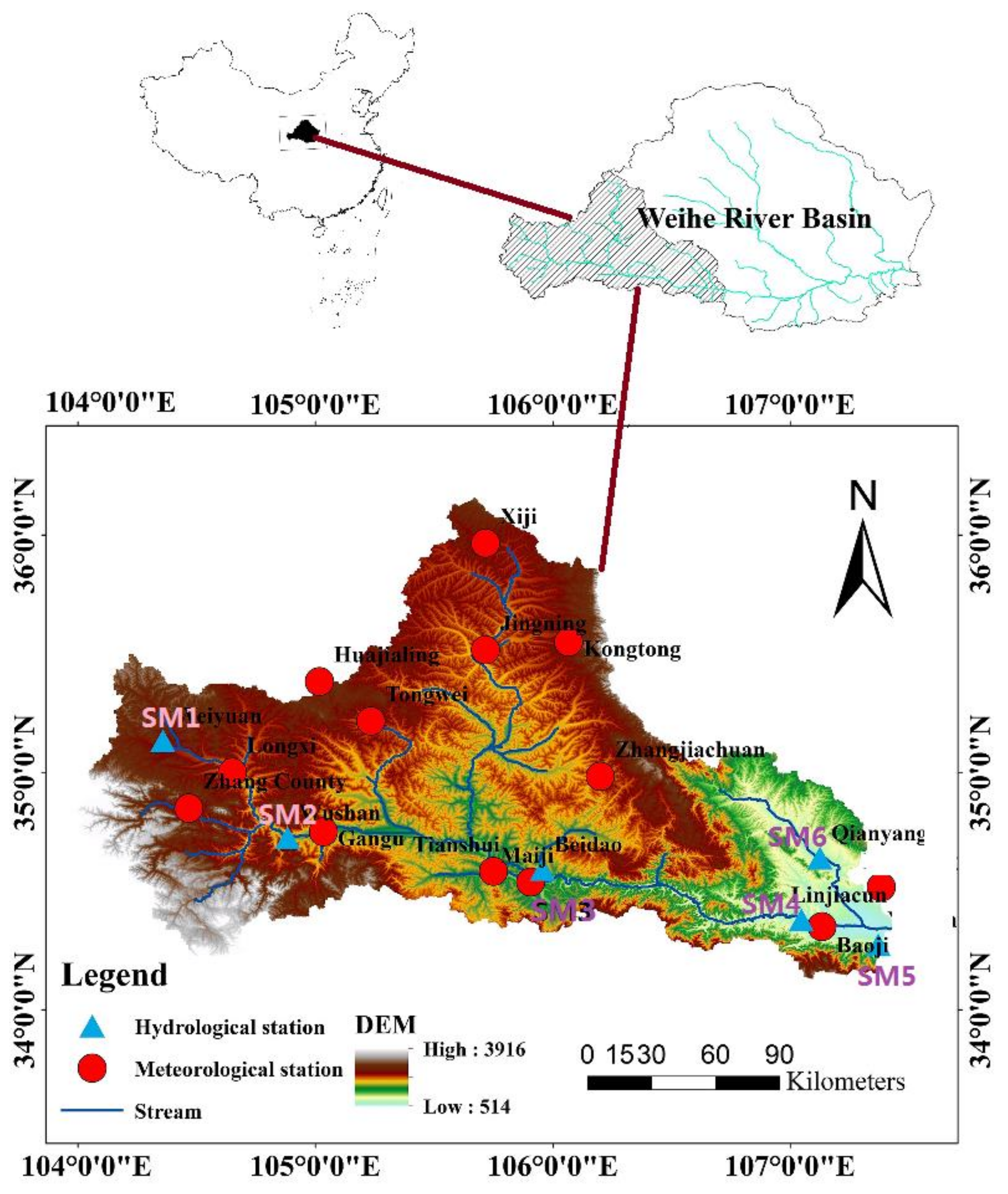
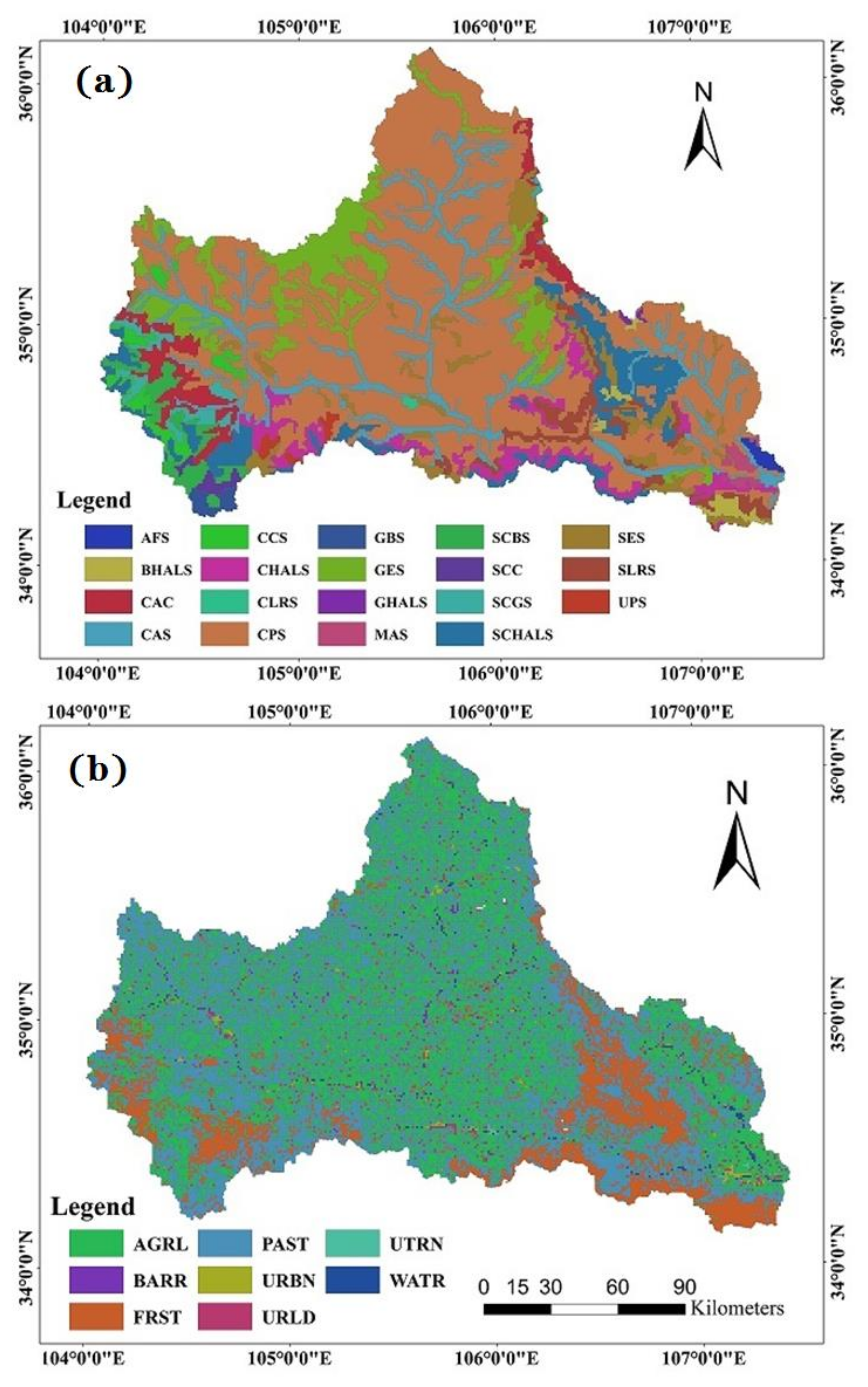
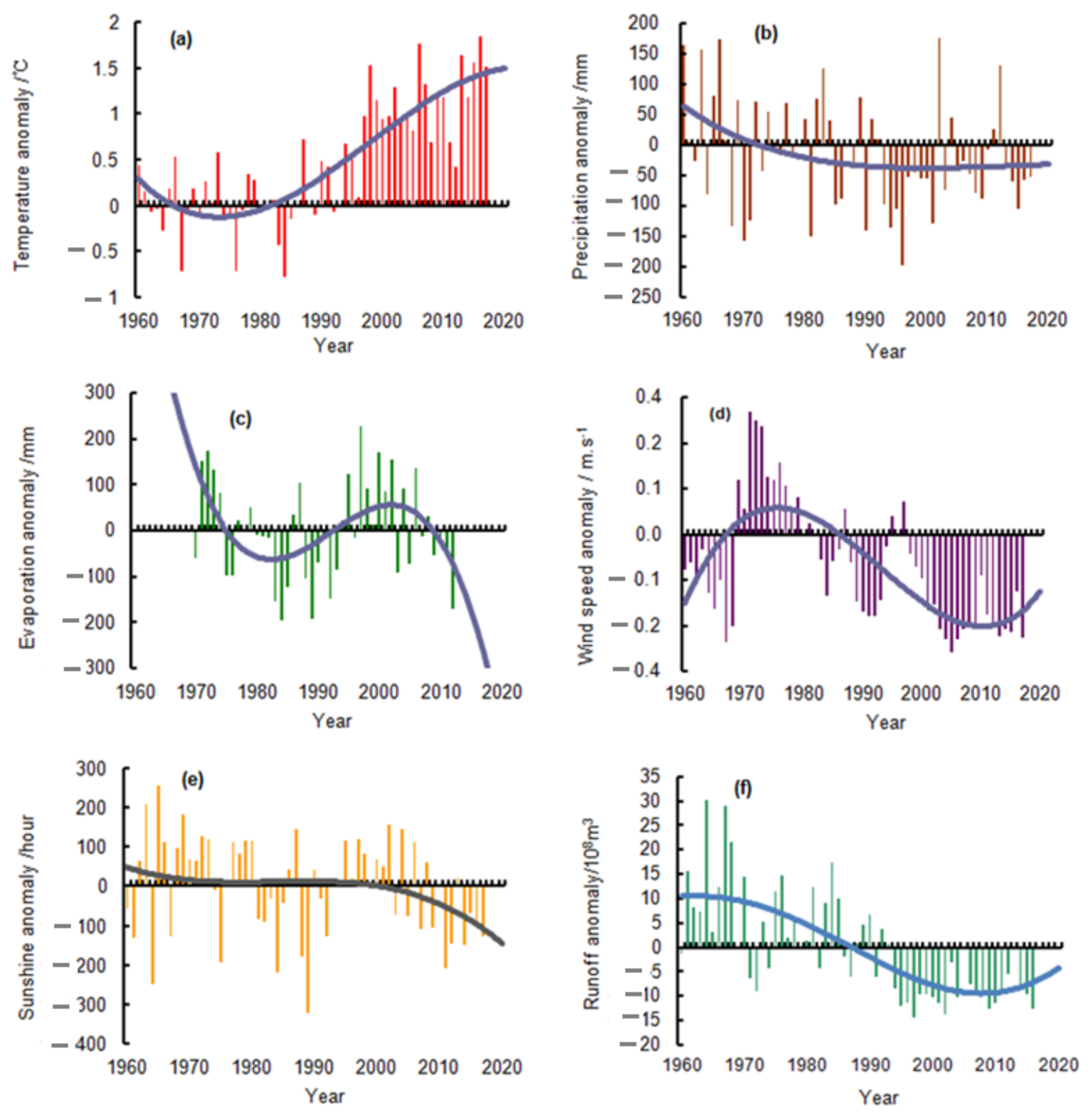
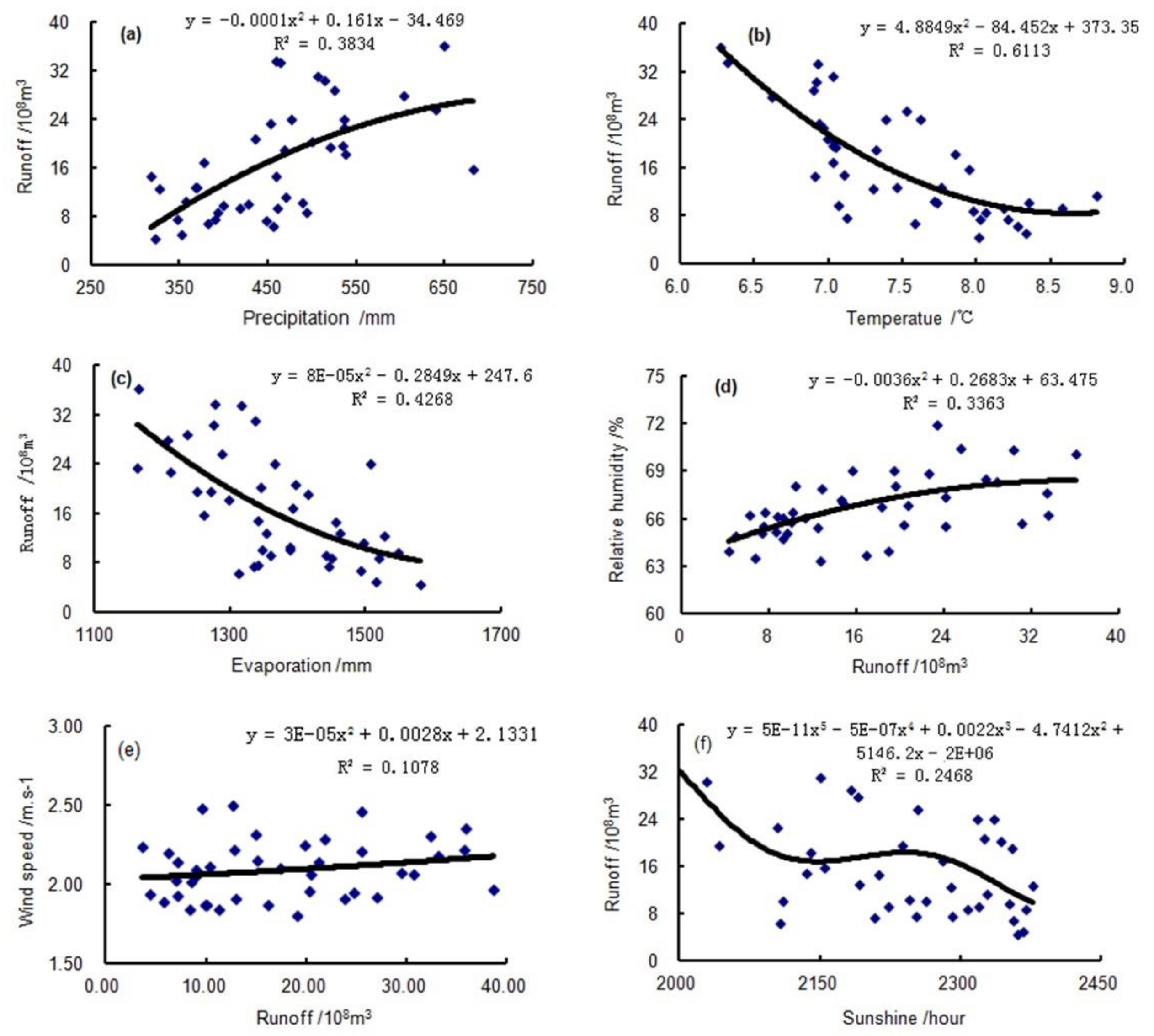

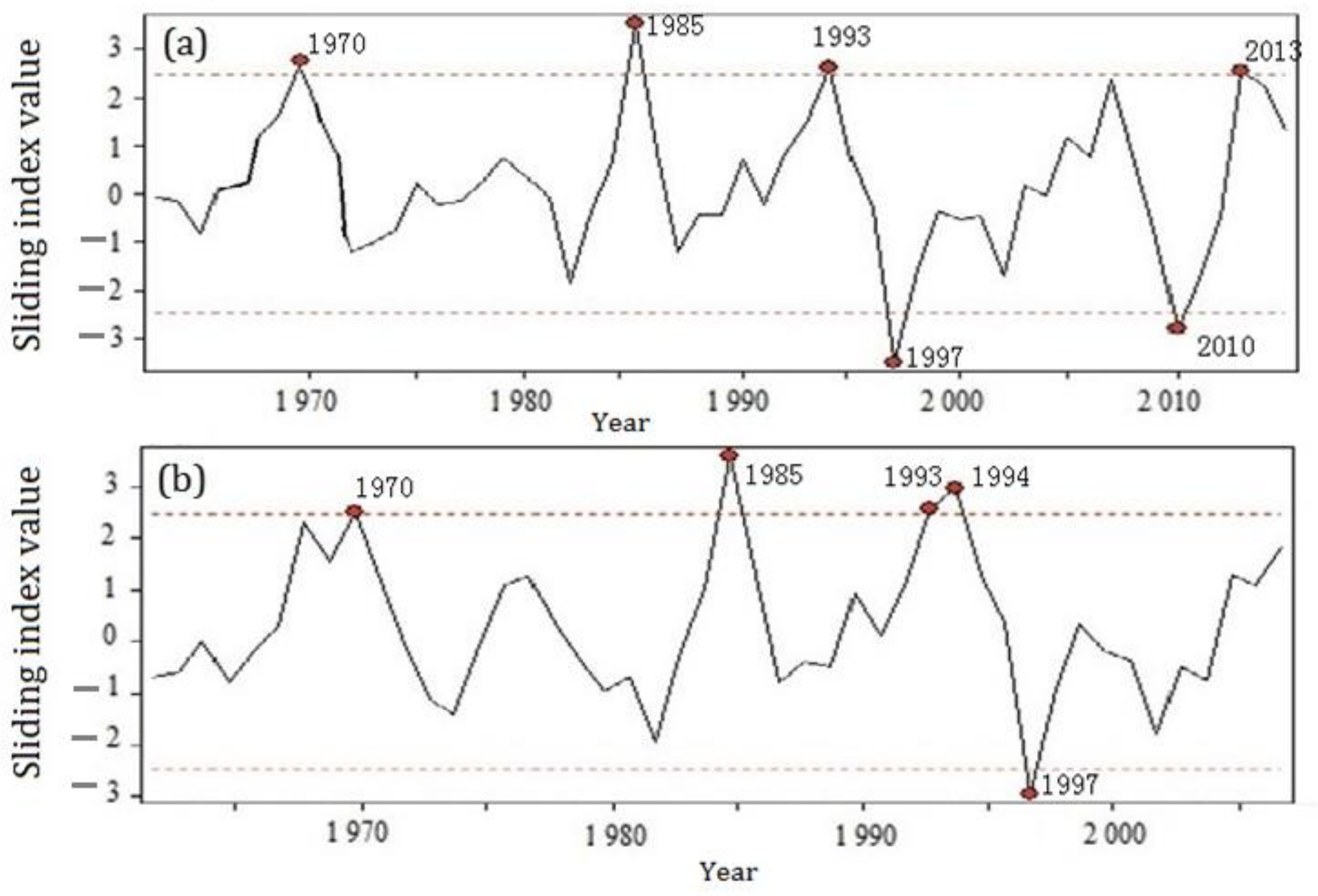
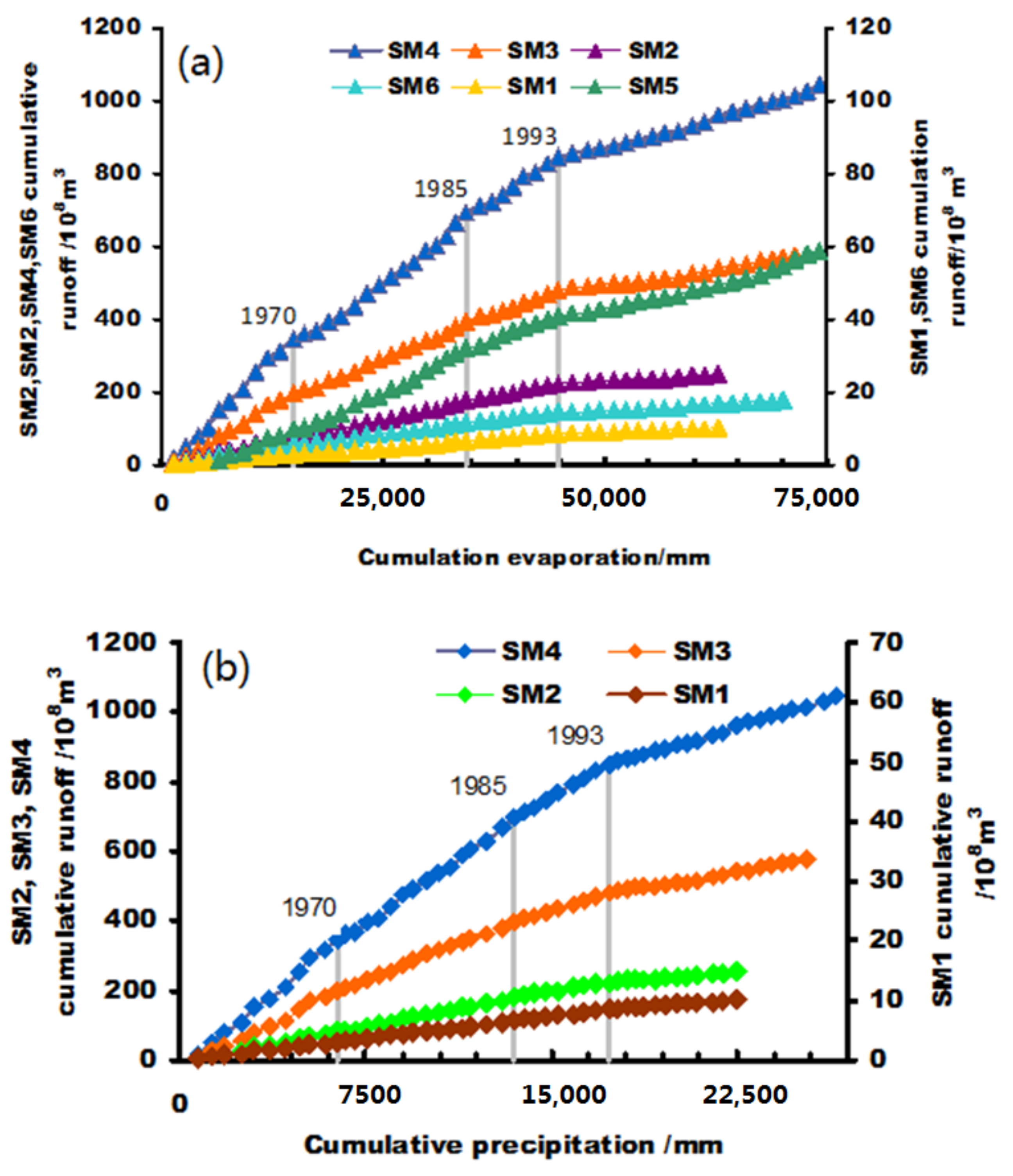
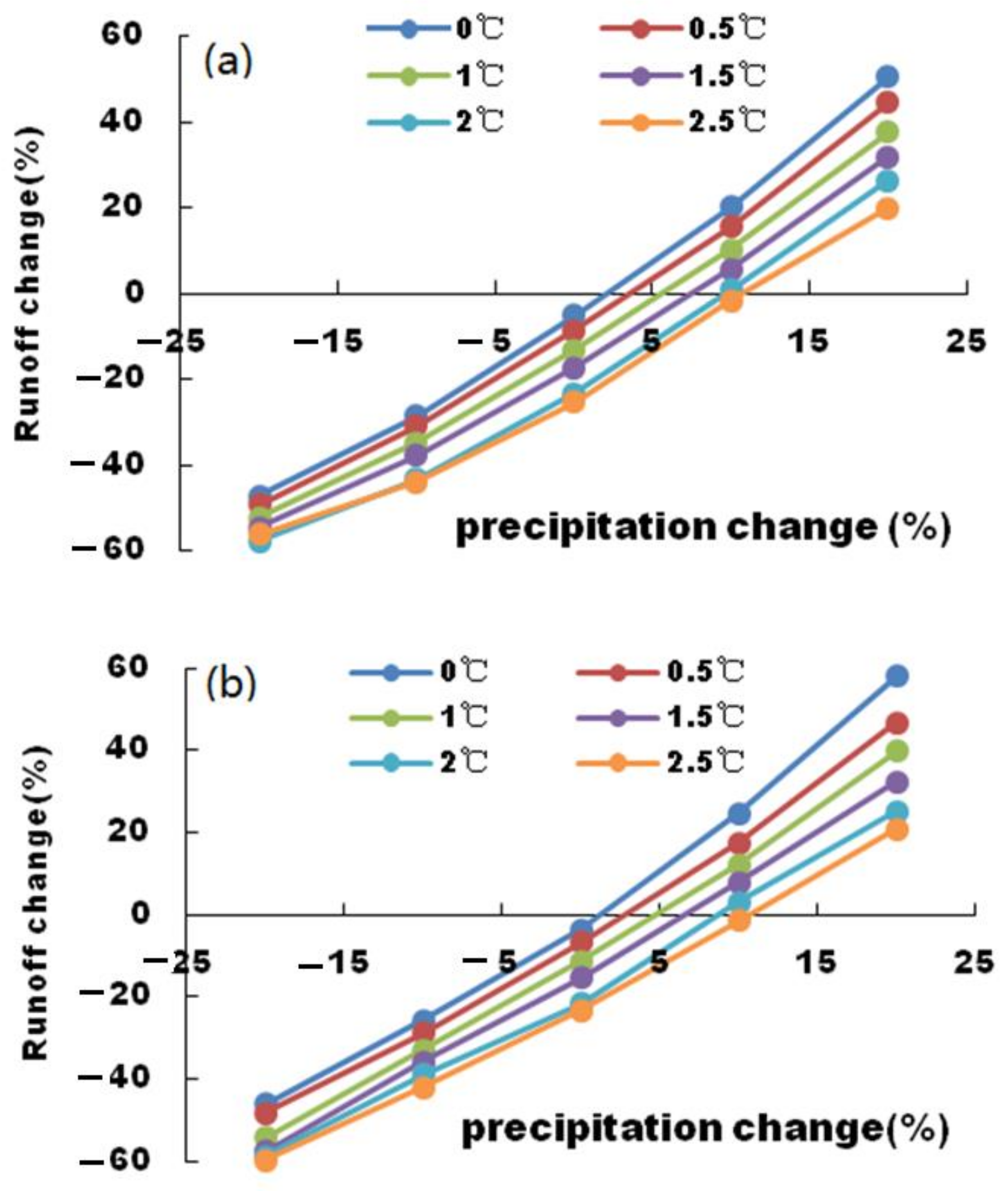
| AGRL | FRST | PAST | WATR | UBRN | URLD | UTRN | BARR |
|---|---|---|---|---|---|---|---|
| 13.817 | 3.838 | 12.384 | 0.195 | 0.119 | 0.636 | 0.045 | 0.112 |
| Period | Precipitation (mm) | Evaporation (mm) | Runoff (108 m3) | |||||
|---|---|---|---|---|---|---|---|---|
| SM1 | SM2 | SM3 | SM4 | SM5 | SM6 | |||
| T1 | 692.17 | 1356.27 | 0.29 | 6.67 | 14.24 | 27.83 | 1.4 | 4.38 |
| T2 | 564.52 | 978.72 | 0.24 | 6.57 | 13.34 | 23.14 | 1.25 | 2.42 |
| T3 | 544.41 | 970.73 | 0.23 | 5.53 | 10.6 | 19.46 | 1.02 | 3.21 |
| T4 | 511.05 | 1022.3 | 0.13 | 2.19 | 5.25 | 9.55 | 0.54 | 1.16 |
| Climatic Variation | Human Activities | |||||||
|---|---|---|---|---|---|---|---|---|
| T1 | T2 | T3 | T4 | T1 | T2 | T3 | T4 | |
| SM1 | 88.56 | 128.78 | 99.08 | 35.53 | 11.44 | −28.78 | 0.92 | 64.47 |
| SM2 | 78.75 | 91.19 | 18.18 | 20.53 | 21.25 | 8.81 | 81.82 | 79.47 |
| SM3 | 66.22 | 14.76 | 8.08 | 13.21 | 33.78 | 85.24 | 91.92 | 86.79 |
| SM4 | 67.17 | 41.25 | 18.47 | 11.40 | 32.83 | 58.75 | 81.53 | 88.60 |
| SM5 | 116.03 | 37.63 | −26.12 | 5.72 | −16.03 | 62.37 | 126.12 | 94.28 |
| SM6 | 54.83 | 46.65 | 42.59 | 32.02 | 45.17 | 53.35 | 57.41 | 67.98 |
Publisher’s Note: MDPI stays neutral with regard to jurisdictional claims in published maps and institutional affiliations. |
© 2022 by the authors. Licensee MDPI, Basel, Switzerland. This article is an open access article distributed under the terms and conditions of the Creative Commons Attribution (CC BY) license (https://creativecommons.org/licenses/by/4.0/).
Share and Cite
Liu, Y.; Yu, K.; Zhao, Y.; Bao, J. Impacts of Climatic Variation and Human Activity on Runoff in Western China. Sustainability 2022, 14, 942. https://doi.org/10.3390/su14020942
Liu Y, Yu K, Zhao Y, Bao J. Impacts of Climatic Variation and Human Activity on Runoff in Western China. Sustainability. 2022; 14(2):942. https://doi.org/10.3390/su14020942
Chicago/Turabian StyleLiu, Yinge, Keke Yu, Yaqian Zhao, and Jiangchuan Bao. 2022. "Impacts of Climatic Variation and Human Activity on Runoff in Western China" Sustainability 14, no. 2: 942. https://doi.org/10.3390/su14020942
APA StyleLiu, Y., Yu, K., Zhao, Y., & Bao, J. (2022). Impacts of Climatic Variation and Human Activity on Runoff in Western China. Sustainability, 14(2), 942. https://doi.org/10.3390/su14020942







